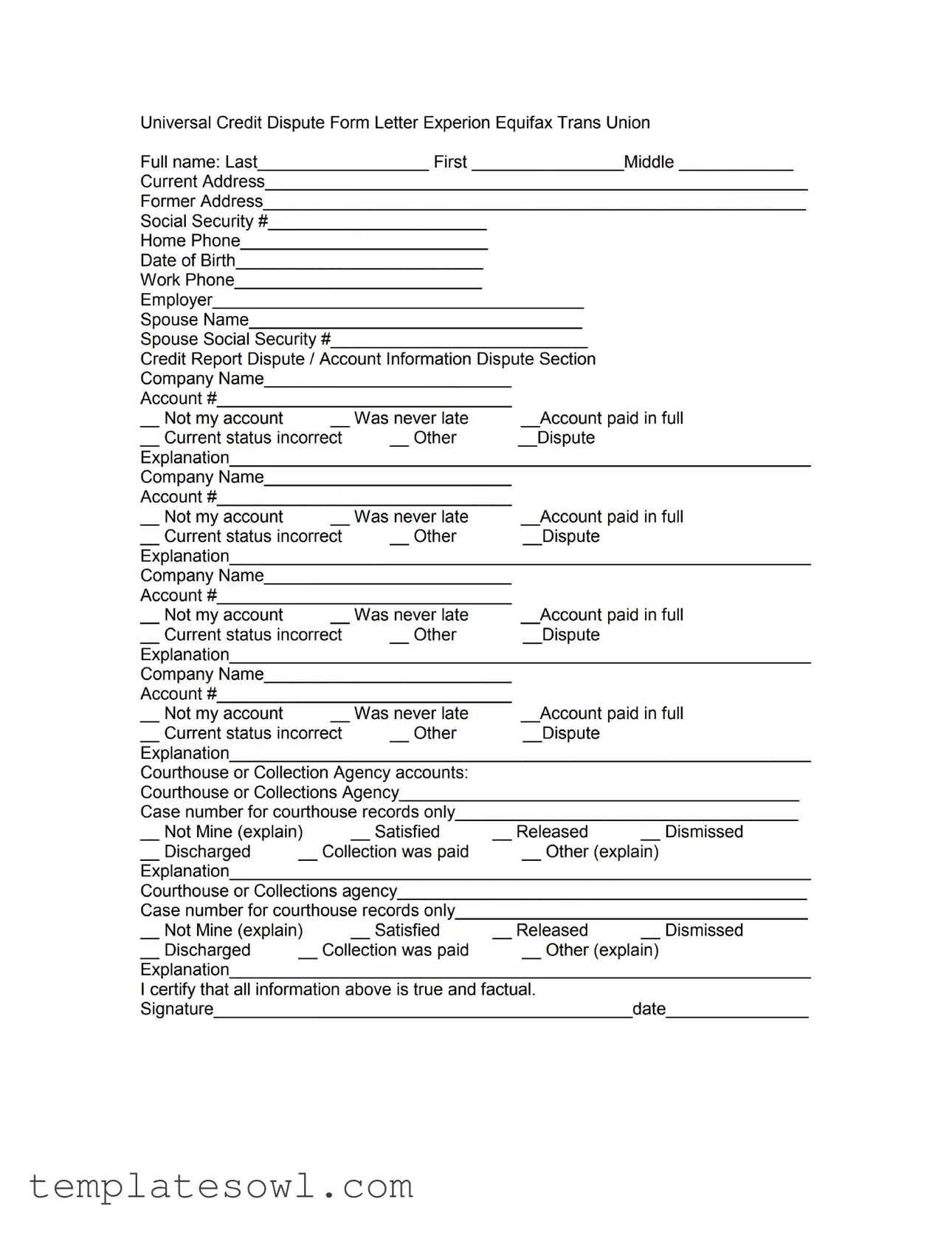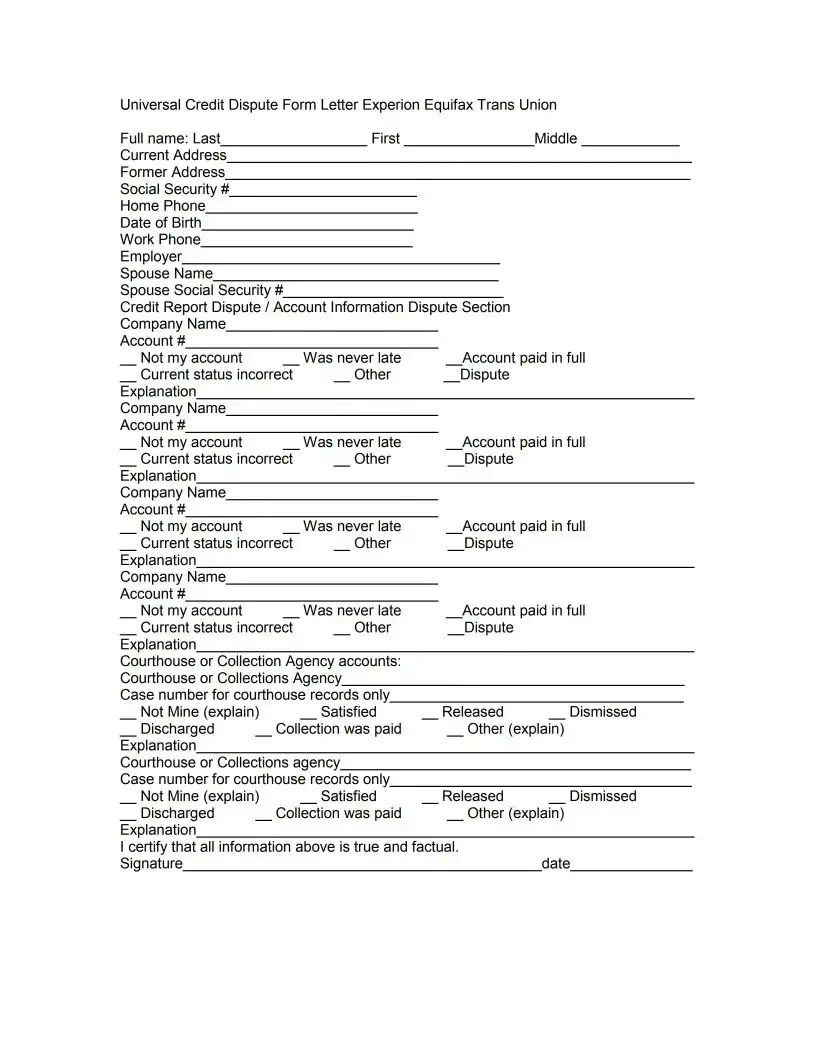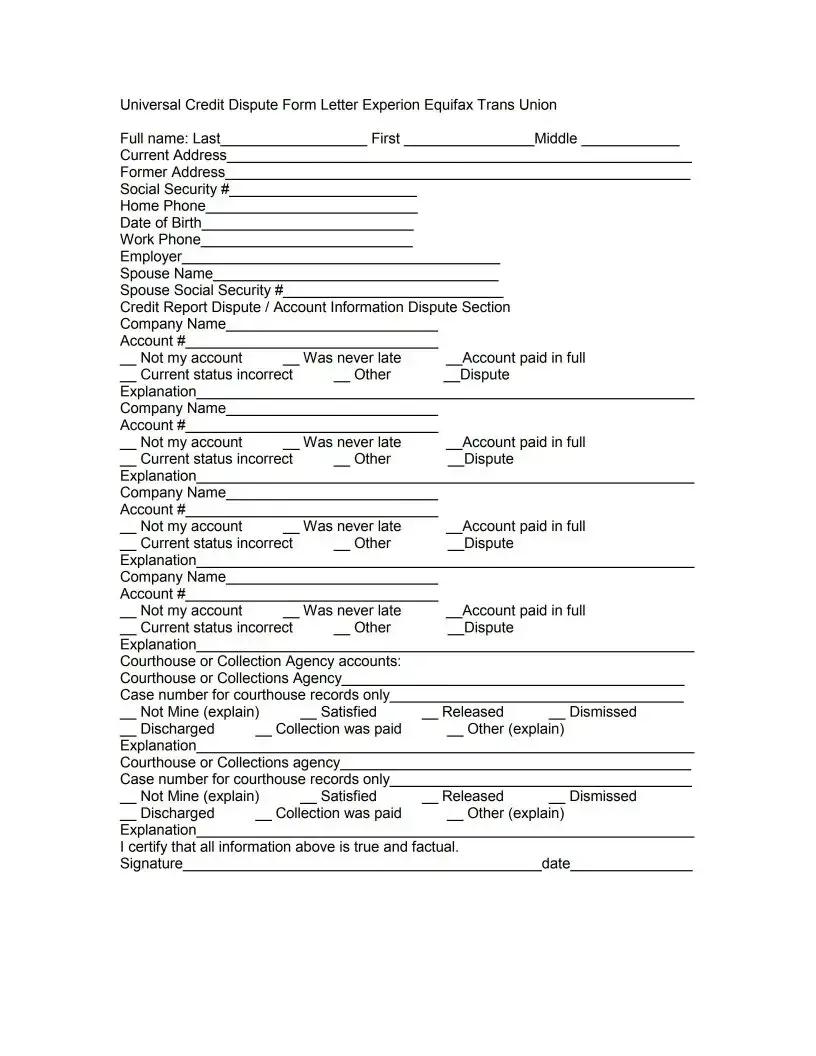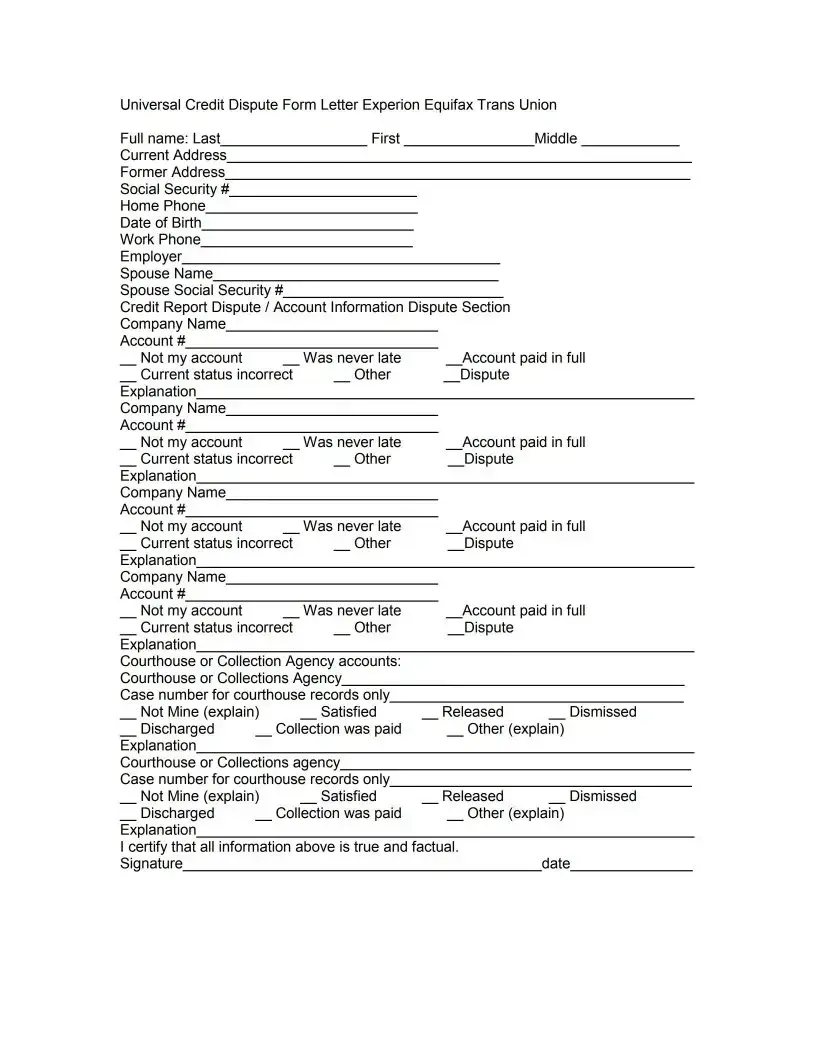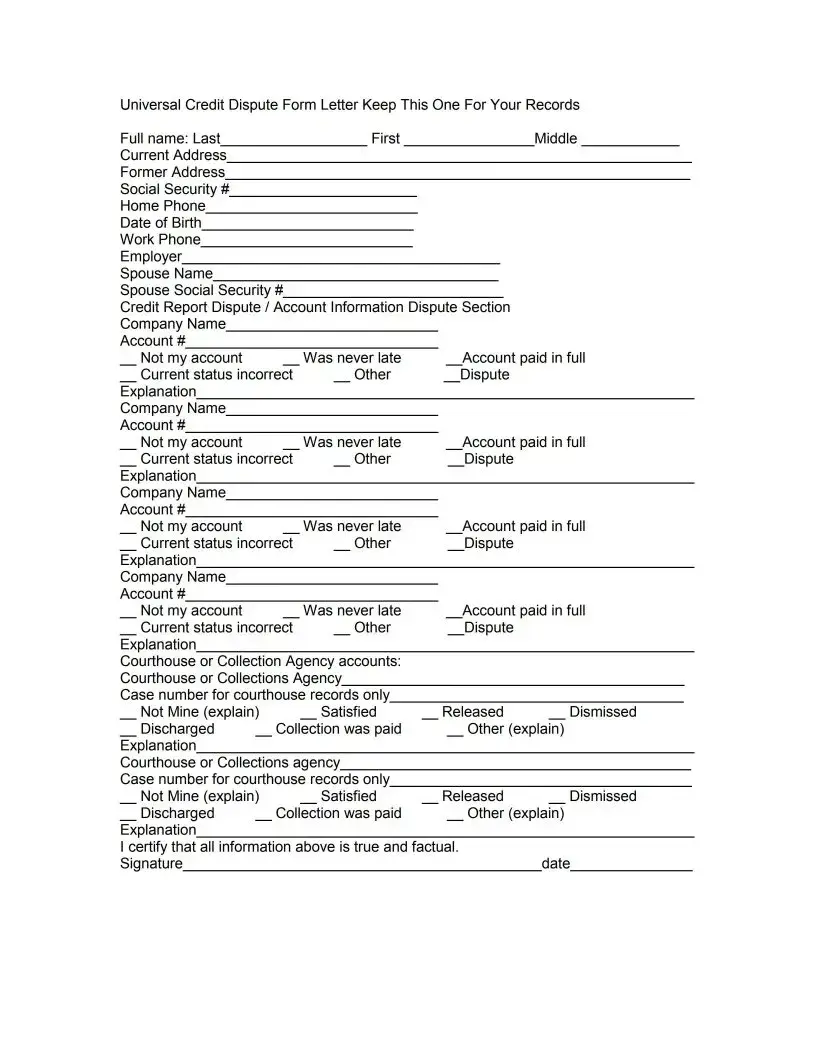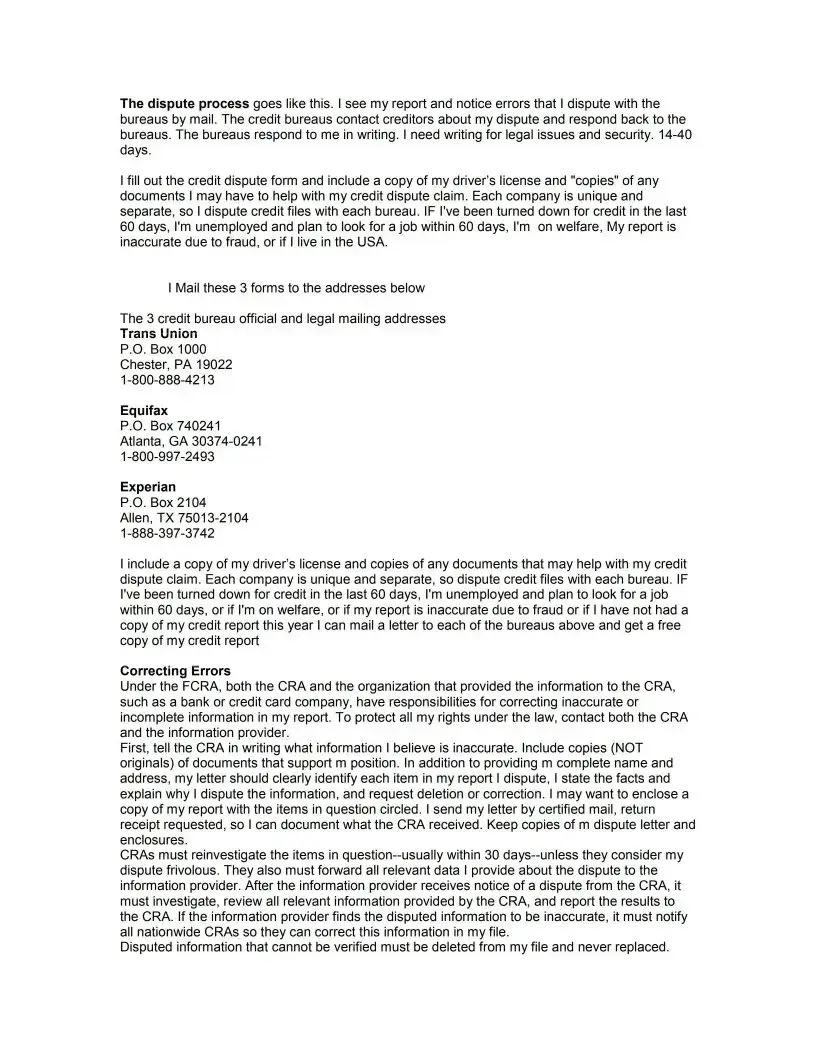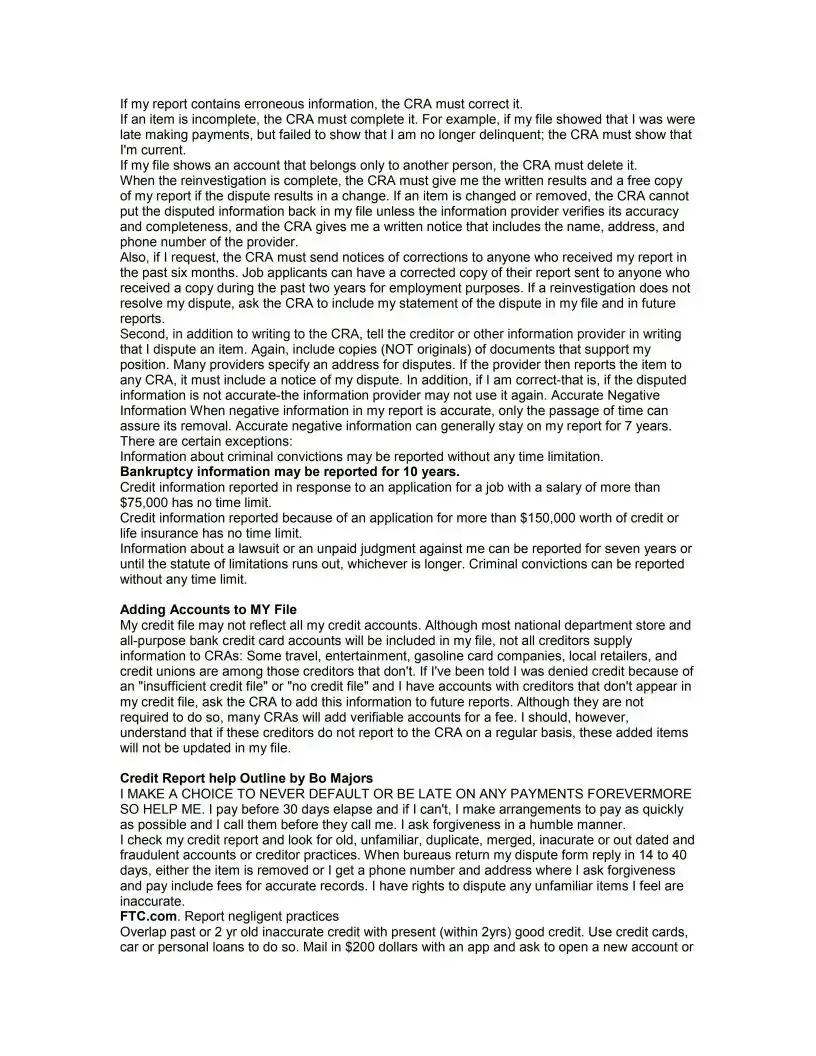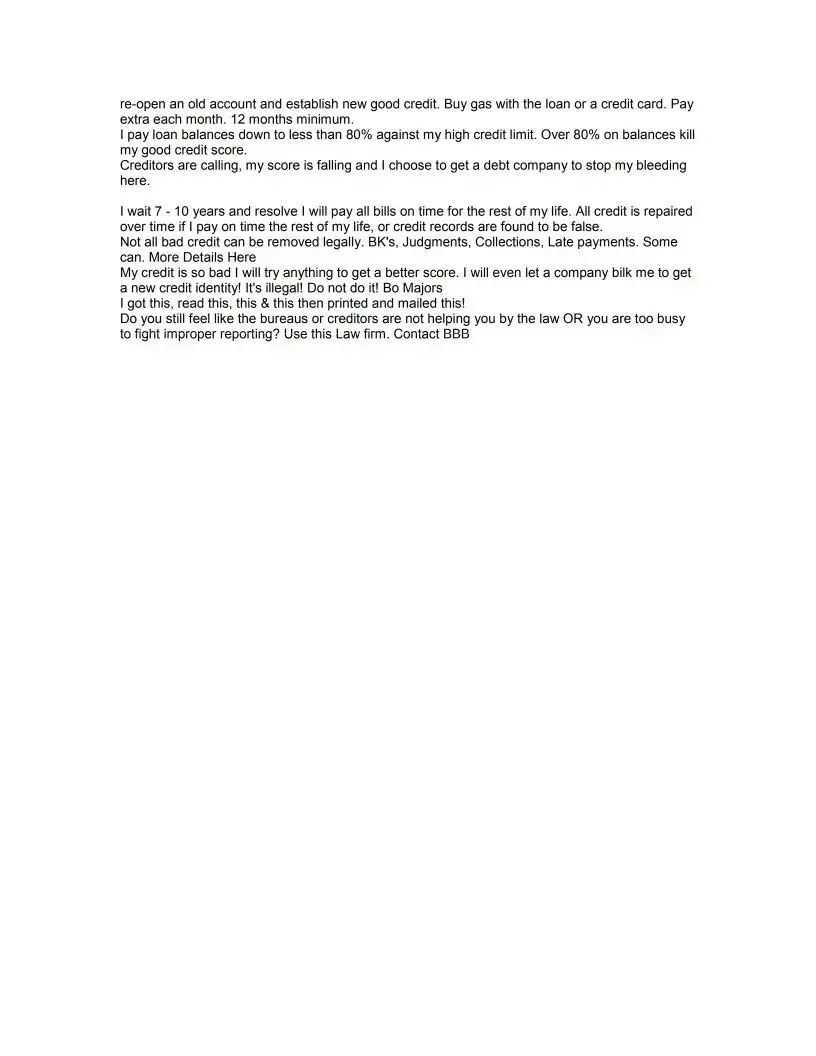Universal Credit Dispute Form Letter Experion Equifax Trans Union
Full name: Last |
First |
Middle |
Current Address |
|
|
Former Add ress |
|
|
Social Security # |
|
|
Home Phone |
|
|
Date of Birth |
|
|
Work Phone |
|
|
E m pIoyer_______________________________________
Spouse Name
Spouse Social Security #
Credit Report Dispute / Account Information Dispute Section
Company Name
Account #
Not my account |
|
Was never late |
Account paid in full |
Current status incorrect |
Other |
Dispute |
|
Explanation |
|
|
|
|
Company Name |
|
|
|
|
Account # |
|
|
|
|
Not my account |
|
Was never late |
Account paid in full |
Current status incorrect |
Other |
Dispute |
|
Explanation |
|
|
|
|
Company Name |
|
|
|
|
Account # |
|
|
|
|
Not my account |
|
Was never late |
Account paid in full |
Current status incorrect |
Other |
Dispute |
|
Explanation |
|
|
|
|
Company Name |
|
|
|
|
Account # |
|
|
|
|
Not my account |
|
Was never late |
Account paid in full |
Current status incorrect |
Other |
Dispute |
|
Explanation |
|
|
|
|
Courthouse or Collection Agency accounts: |
|
|
Courthouse or Collections Agency |
|
|
Case number for courthouse records only |
|
|
Not Mine (explain) |
|
Satisfied |
Released |
Dismissed |
Discharged |
Collection was paid |
Other (explain) |
|
Explanation |
|
|
|
|
Courthouse or Collections agency |
|
|
Case number for courthouse records only |
|
|
Not Mine (explain) |
|
Satisfied |
Released |
Dismissed |
Discharged |
Collection was paid |
Other (explain) |
|
Explanation |
|
|
|
|
I certify that all information above is true and factual.
Signaturedate
Universal Credit Dispute Form Letter Experion Equifax Trans Union
Full name: Last |
First |
Middle |
Current Address |
|
|
Former Add ress |
|
|
Social Security # |
|
|
Home Phone |
|
|
Date of Birth |
|
|
Work Phone |
|
|
E m pIoyer_______________________________________
Spouse Name
Spouse Social Security #
Credit Report Dispute / Account Information Dispute Section
Company Name
Account #
Not my account |
|
Was never late |
Account paid in full |
Current status incorrect |
Other |
Dispute |
|
Explanation |
|
|
|
|
Company Name |
|
|
|
|
Account # |
|
|
|
|
Not my account |
|
Was never late |
Account paid in full |
Current status incorrect |
Other |
Dispute |
|
Explanation |
|
|
|
|
Company Name |
|
|
|
|
Account # |
|
|
|
|
Not my account |
|
Was never late |
Account paid in full |
Current status incorrect |
Other |
Dispute |
|
Explanation |
|
|
|
|
Company Name |
|
|
|
|
Account # |
|
|
|
|
Not my account |
|
Was never late |
Account paid in full |
Current status incorrect |
Other |
Dispute |
|
Explanation |
|
|
|
|
Courthouse or Collection Agency accounts: |
|
|
Courthouse or Collections Agency |
|
|
Case number for courthouse records only |
|
|
Not Mine (explain) |
|
Satisfied |
Released |
Dismissed |
Discharged |
Collection was paid |
Other (explain) |
|
Explanation |
|
|
|
|
Courthouse or Collections agency |
|
|
Case number for courthouse records only |
|
|
Not Mine (explain) |
|
Satisfied |
Released |
Dismissed |
Discharged |
Collection was paid |
Other (explain) |
|
Explanation |
|
|
|
|
I certify that all information above is true and factual. |
|
Signature |
|
|
date |
|
Universal Credit Dispute Form Letter Experion Equifax Trans Union
Full name: Last |
First |
Middle |
Current Address |
|
|
Former Add ress |
|
|
Social Security # |
|
|
Home Phone |
|
|
Date of Birth |
|
|
Work Phone |
|
|
E m pIoyer_______________________________________
Spouse Name
Spouse Social Security #
Credit Report Dispute / Account Information Dispute Section
Company Name
Account #
Not my account |
|
Was never late |
Account paid in full |
Current status incorrect |
Other |
Dispute |
|
Explanation |
|
|
|
|
Company Name |
|
|
|
|
Account # |
|
|
|
|
Not my account |
|
Was never late |
Account paid in full |
Current status incorrect |
Other |
Dispute |
|
Explanation |
|
|
|
|
Company Name |
|
|
|
|
Account # |
|
|
|
|
Not my account |
|
Was never late |
Account paid in full |
Current status incorrect |
Other |
Dispute |
|
Explanation |
|
|
|
|
Company Name |
|
|
|
|
Account # |
|
|
|
|
Not my account |
|
Was never late |
Account paid in full |
Current status incorrect |
Other |
Dispute |
|
Explanation |
|
|
|
|
Courthouse or Collection Agency accounts: |
|
|
Courthouse or Collections Agency |
|
|
Case number for courthouse records only |
|
|
Not Mine (explain) |
|
Satisfied |
Released |
Dismissed |
Discharged |
Collection was paid |
Other (explain) |
|
Explanation |
|
|
|
|
Courthouse or Collections agency |
|
|
Case number for courthouse records only |
|
|
Not Mine (explain) |
|
Satisfied |
Released |
Dismissed |
Discharged |
Collection was paid |
Other (explain) |
|
Explanation |
|
|
|
|
I certify that all information above is true and factual. |
|
Signature |
|
|
date |
|
Universal Credit Dispute Form Letter Keep This One For Your Records
Full name: Last |
First |
Middle |
Current Address |
|
|
Former Add ress |
|
|
Social Security # |
|
|
Home Phone |
|
|
Date of Birth |
|
|
Work Phone |
|
|
E m pIoyer_______________________________________
Spouse Name
Spouse Social Security #
Credit Report Dispute / Account Information Dispute Section
Company Name
Account #
Not my account |
|
Was never late |
Account paid in full |
Current status incorrect |
Other |
Dispute |
|
Explanation |
|
|
|
|
Company Name |
|
|
|
|
Account # |
|
|
|
|
Not my account |
|
Was never late |
Account paid in full |
Current status incorrect |
Other |
Dispute |
|
Explanation |
|
|
|
|
Company Name |
|
|
|
|
Account # |
|
|
|
|
Not my account |
|
Was never late |
Account paid in full |
Current status incorrect |
Other |
Dispute |
|
Explanation |
|
|
|
|
Company Name |
|
|
|
|
Account # |
|
|
|
|
Not my account |
|
Was never late |
Account paid in full |
Current status incorrect |
Other |
Dispute |
|
Explanation |
|
|
|
|
Courthouse or Collection Agency accounts: |
|
|
Courthouse or Collections Agency |
|
|
Case number for courthouse records only |
|
|
Not Mine (explain) |
|
Satisfied |
Released |
Dismissed |
Discharged |
Collection was paid |
Other (explain) |
|
Explanation |
|
|
|
|
Courthouse or Collections agency |
|
|
Case number for courthouse records only |
|
|
Not Mine (explain) |
|
Satisfied |
Released |
Dismissed |
Discharged |
Collection was paid |
Other (explain) |
|
Explanation |
|
|
|
|
I certify that all information above is true and factual. |
|
Signature |
|
|
date |
|
The dispute process goes like this. I see my report and notice errors that I dispute with the
bureaus by mail. The credit bureaus contact creditors about my dispute and respond back to the bureaus. The bureaus respond to me in writing. I need writing for legal issues and security. 14-40 days.
I fill out the credit dispute form and include a copy of my driver’s license and "copies" of any documents I may have to help with my credit dispute claim. Each company is unique and separate, so I dispute credit files with each bureau. IF I've been turned down for credit in the last 60 days, I'm unemployed and plan to look for a job within 60 days, I'm on welfare, My report is inaccurate due to fraud, or if I live in the USA.
I Mail these 3 forms to the addresses below
The 3 credit bureau official and legal mailing addresses
Trans Union
P.O. Box 1000
Chester, PA 19022
1-800-888-4213
Equifax
P.O. Box 740241
Atlanta, GA 30374-0241
1-800-997-2493
Experian
P.O. Box 2104
Allen, TX 75013-2104
1-888-397-3742
I include a copy of my driver’s license and copies of any documents that may help with my credit dispute claim. Each company is unique and separate, so dispute credit files with each bureau. IF I've been turned down for credit in the last 60 days, I'm unemployed and plan to look for a job within 60 days, or if I'm on welfare, or if my report is inaccurate due to fraud or if I have not had a copy of my credit report this year I can mail a letter to each of the bureaus above and get a free copy of my credit report
Correcting Errors
Under the FCRA, both the CRA and the organization that provided the information to the CRA, such as a bank or credit card company, have responsibilities for correcting inaccurate or incomplete information in my report. To protect all my rights under the law, contact both the CRA and the information provider.
First, tell the CRA in writing what information I believe is inaccurate. Include copies (NOT originals) of documents that support m position. In addition to providing m complete name and address, my letter should clearly identify each item in my report I dispute, I state the facts and explain why I dispute the information, and request deletion or correction. I may want to enclose a copy of my report with the items in question circled. I send my letter by certified mail, return receipt requested, so I can document what the CRA received. Keep copies of m dispute letter and enclosures.
CRAs must reinvestigate the items in question-usually within 30 days--unless they consider my dispute frivolous. They also must forward all relevant data I provide about the dispute to the information provider. After the information provider receives notice of a dispute from the CRA, it must investigate, review all relevant information provided by the CRA, and report the results to the CRA. If the information provider finds the disputed information to be inaccurate, it must notify all nationwide CRAs so they can correct this information in my file.
Disputed information that cannot be verified must be deleted from my file and never replaced.
If my report contains erroneous information, the CRA must correct it.
If an item is incomplete, the CRA must complete it. For example, if my file showed that I was were late making payments, but failed to show that I am no longer delinquent; the CRA must show that I'm current.
If my file shows an account that belongs only to another person, the CRA must delete it.
When the reinvestigation is complete, the CRA must give me the written results and a free copy of my report if the dispute results in a change. If an item is changed or removed, the CRA cannot put the disputed information back in my file unless the information provider verifies its accuracy and completeness, and the CRA gives me a written notice that includes the name, address, and phone number of the provider.
Also, if I request, the CRA must send notices of corrections to anyone who received my report in the past six months. Job applicants can have a corrected copy of their report sent to anyone who received a copy during the past two years for employment purposes. If a reinvestigation does not resolve my dispute, ask the CRA to include my statement of the dispute in my file and in future reports.
Second, in addition to writing to the CRA, tell the creditor or other information provider in writing that I dispute an item. Again, include copies (NOT originals) of documents that support my position. Many providers specify an address for disputes. If the provider then reports the item to any CRA, it must include a notice of my dispute. In addition, if I am correct-that is, if the disputed information is not accurate-the information provider may not use it again. Accurate Negative Information When negative information in my report is accurate, only the passage of time can assure its removal. Accurate negative information can generally stay on my report for 7 years. There are certain exceptions:
Information about criminal convictions may be reported without any time limitation.
Bankruptcy information may be reported for 10 years.
Credit information reported in response to an application for a job with a salary of more than $75,000 has no time limit.
Credit information reported because of an application for more than $150,000 worth of credit or life insurance has no time limit.
Information about a lawsuit or an unpaid judgment against me can be reported for seven years or until the statute of limitations runs out, whichever is longer. Criminal convictions can be reported without any time limit.
Adding Accounts to MY File
My credit file may not reflect all my credit accounts. Although most national department store and all-purpose bank credit card accounts will be included in my file, not all creditors supply information to CRAs: Some travel, entertainment, gasoline card companies, local retailers, and credit unions are among those creditors that don't. If I've been told I was denied credit because of an "insufficient credit file" or "no credit file" and I have accounts with creditors that don't appear in my credit file, ask the CRA to add this information to future reports. Although they are not required to do so, many CRAs will add verifiable accounts for a fee. I should, however, understand that if these creditors do not report to the CRA on a regular basis, these added items will not be updated in my file.
Credit Report help Outline by Bo Majors
I MAKE A CHOICE TO NEVER DEFAULT OR BE LATE ON ANY PAYMENTS FOREVERMORE SO HELP ME. I pay before 30 days elapse and if I can't, I make arrangements to pay as quickly as possible and I call them before they call me. I ask forgiveness in a humble manner.
I check my credit report and look for old, unfamiliar, duplicate, merged, inacurate or out dated and fraudulent accounts or creditor practices. When bureaus return my dispute form reply in 14 to 40 days, either the item is removed or I get a phone number and address where I ask forgiveness and pay include fees for accurate records. I have rights to dispute any unfamiliar items I feel are inaccurate.
FTC.com. Report negligent practices
Overlap past or 2 yr old inaccurate credit with present (within 2yrs) good credit. Use credit cards, car or personal loans to do so. Mail in $200 dollars with an app and ask to open a new account or
re-open an old account and establish new good credit. Buy gas with the loan or a credit card. Pay extra each month. 12 months minimum.
I pay loan balances down to less than 80% against my high credit limit. Over 80% on balances kill my good credit score.
Creditors are calling, my score is falling and I choose to get a debt company to stop my bleeding here.
I wait 7-10 years and resolve I will pay all bills on time for the rest of my life. All credit is repaired over time if I pay on time the rest of my life, or credit records are found to be false.
Not all bad credit can be removed legally. BK's, Judgments, Collections, Late payments. Some can. More Details Here
My credit is so bad I will try anything to get a better score. I will even let a company bilk me to get a new credit identity! It's illegal! Do not do it! Bo Majors
I got this, read this, this & this then printed and mailed this!
Do you still feel like the bureaus or creditors are not helping you by the law OR you are too busy to fight improper reporting? Use this Law firm. Contact BBB
